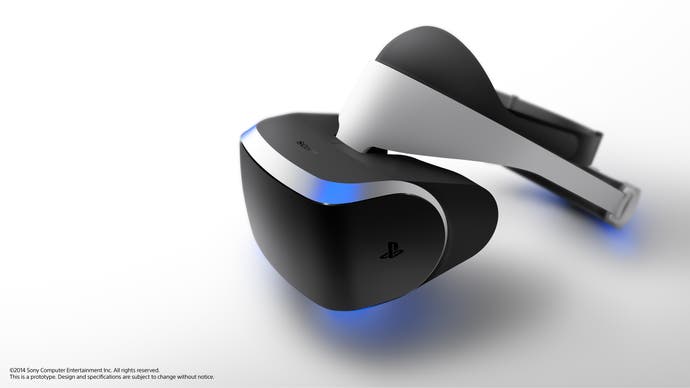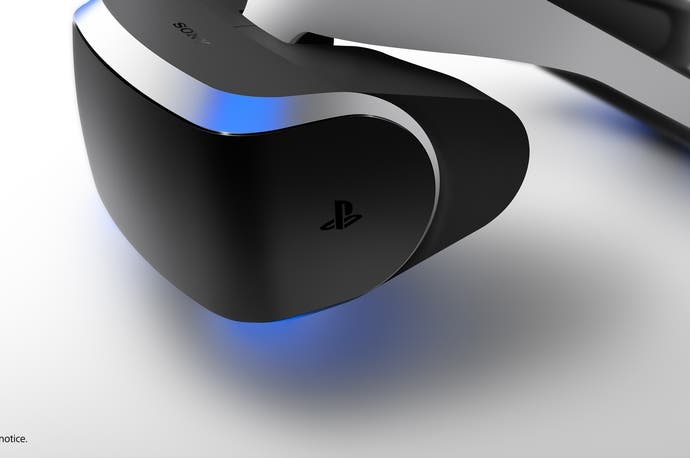How does Project Morpheus compare to Oculus Rift?
First impressions of Sony's VR unit.
Just under two years ago, John Carmack revealed a virtual reality dream. It was a charmingly sketchy one back then, too, a hastily hung together prototype created by wunderkind Palmer Luckey, but even through the masking tape and ski goggles the future it suggested was intoxicating. The Oculus Rift has become a tangible, tantalising prospect since, and Sony's entry into the market with Project Morpheus, while not exactly validating VR, is a sure sign that the dream is drawing ever closer.
Project Morpheus, perhaps unsurprisingly given the breadth of Sony's expertise and resources, comes strong off the blocks. As an experience it's comparable to Oculus - to the DK2, that is, the most recent iteration of the headset that incorporates Crystal Cove and that opened up pre-orders yesterday - although there are clear points of differentiation.
First is the unit itself. Morpheus is a sleek, handsomely designed piece of kit, and as an object it's certainly more desirable than the Oculus. It's easy to slip on, easy to adjust and, it seems, a little lighter - probably due to the fact that much of the processing is done by a separate box that sits between the headset and the PS4 with an HDMI in and out. This slim piece of kit generates the image for the TV screen that makes for some fascinating gameplay potential - but a little more on that later.

So the headset's well-designed, although it does lag behind the Oculus in some key areas. There's a fair bit more light bleeding into the viewing area, a slim slit just below your field of vision that doesn't seem to be rectifiable by adjusting the optics. The viewing angle, too, is noticeably smaller than the Oculus, even if the difference is minimal - on your visual peripheral there's a clear edge to the image, though it's thankfully slight enough not to break the feeling of immersion.
And what a feeling of immersion it is. Project Morpheus' tracking feels on a par with Oculus, even taking into account the advances brought about by the implementation of Crystal Cove. That's no doubt thanks to the PlayStation Camera's input, and the latency seems impressively low when moving your head. Even better, it allows you full 360-degree movement, letting you look behind you - a factor that's exploited to great effect in Sony London Studio's The Deep.
There is one other setback to Morpheus right now, though it's one that's likely to be remedied throughout the development process. Motion blur is much more pronounced on Morpheus than it is on Oculus' DK2, and image quality is also noticeably not quite on par. Both are running at 1080p, but Morpheus' decision to go with LCD displays rather than the OLED used on Oculus hurts it a little - good thing, then, that Sony's already looking at exploring OLED for its own device.
The experiences themselves, though, show clearer gaps between the two. The Deep, a short, barely interactive experience that casts you under the sea in a diving cage, shows how the ability to look behind you works wonders for Morpheus. First you're sitting just below the waves as shafts of sunlight shear through the water and a boat bobs just above you, giving you some small sense of security. Tropical fish move in through the cage, dancing past your field of vision and moving behind you, where you can track them as they exit into the blue beyond.
"Project Morpheus' tracking feels on a par with Oculus, even taking into account the advances brought about by the implementation of Crystal Cove."
As the cage is lowered, though, the sense of creeping fear is seriously impressive, the darkening water threatening bigger, more dangerous creatures. And sure enough one emerges from the murkiness, a wonderfully realised great white shark filling your sights before it moves past and back into the darkness. Scanning the waters, trying to anticipate its return, is an anxious experience, and there's some wonderful direction and well-played jump scares as the shark returns to take several bites from your cage.
The Castle demo shows where Morpheus' other advantages come into play. You're in a courtyard, wielding two PlayStation Move controllers that control a pair of in-game hands. With them you can knock around a rag doll knight, or pick up nearby swords to slice off its limbs one by one. You can even reach out and grab separate parts of the knight, holding its head up before severing it in one swift swipe. What's really impressive is how you can move about in that space - the PlayStation Camera allows you a relatively large field of movement, allowing you to walk around a small area of the courtyard. By the time a large dragon sweeps into view before coming crashing down in the courtyard, towering over you, it's hard not to feel totally immersed within the game world.

So immersed, in fact, that it's easy to forget that other people around you may be watching and, thanks to the separate box that feeds a non-distorted view of what you're seeing onto the television screen, witnessing your actions - something I wished I'd taken into account when I pulled both legs of the rag doll up and over my shoulders and proceeded to pull its crotch into my face. (Jetlag can make you do strange things on a trade show floor.)
The possibilities, though, are mesmerising, especially for anyone taken with asymmetric gameplay. Nintendo Land has already proven the power of giving players different perspectives, and the idea of someone being able to manipulate the space another person is immersed in gives rise to all sorts of devious gameplay ideas.
Morpheus is impressive, then, and as a starting point for Sony's work with virtual reality it's encouraging that it's already achieved a parity of sorts with Oculus, a device that's benefitted from the input of an entire community. There are still reservations, though - The Deep and Castle were both running on PS4, and as relatively non-interactive experiences they still offered an exciting insight into what's possible on Morpheus. More traditional games like Eve Valkyrie and Thief though - the latter sadly wasn't available to play at today's demo - are currently running on PC. Whether they can be replicated on console hardware given the increased resource demands of feeding both eyes individual images at high resolution remains to be seen, and in aligning itself with the PC Oculus has partnered with a platform that's only going to get more powerful by the year, whereas Morpheus is currently working on one that's fixed and could find itself rapidly outgunned by its partner.
What Sony does have, though, is the ecosystem to make virtual reality a viable proposition for the living room - and in its open-armed relationship with indie developers, it's also got a community of its own who will help shape the future of what feels like the most exciting, disruptive technology to come to video games in an age. Regardless of that, though, it's made an accomplished start, and brought the VR dream a significant step closer to becoming a reality for all.

